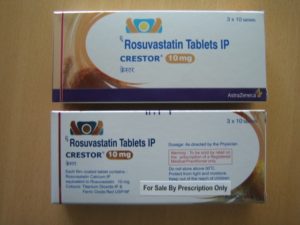by Gabriel Levitt, President, PharmacyChecker.com and Prescription Justice | May 12, 2016 | Drug Prices, FDA, Generic drugs, Local Pharmacies, Online Pharmacies, Saving Money on Prescription Drugs

Brand Name Crestor: Made in Puerto Rico under FDA’s regulations.
Rosuvastatin is now available in U.S. pharmacies as a generic but you can get Crestor 10mg, the brand version, 94% cheaper online. To put some flesh and bones, dollars and sense (pun intended) to this percentile: Ninety pills of generic rosuvastatin cost a whopping $795 at a Walgreens in Brooklyn, NY, but 90 pills of brand name Crestor is $45.65 at a low-cost international online pharmacy, one that is verified by PharmacyChecker.com.
What about using a prescription discount card to buy generic Crestor? Drug price comparison company GoodRx offers a coupon to be used at Rite Aid Pharmacy for a price of $329.52 – still more than seven times the price to get Crestor from an online pharmacy.
Care to know where these drugs are made? It may surprise you. (more…)
Tagged with: Crestor, rosuvastatin
by Tod Cooperman, M.D., CEO, PharmacyChecker.com | Feb 10, 2016 | Drug Prices, Local Pharmacies, Online Pharmacies
The article “Taming Drug Prices by Pulling Back the Curtain Online” in the New York Times (February 10, 2016) features a new website, Blink Health, which shows reduced drug prices available through local U.S. pharmacies. Its limitation is that savings are mostly on generic drugs, which, for the most part, are already fairly inexpensive. Describing Blink and a similar site, GoodRx, the article notes that, “The sites cannot help much with brand-name drugs, which are made by a single manufacturer and carry prices that can be as high as hundreds of thousands of dollars.”
The article fails to mention that the largest pharmacy savings on the Internet are from international online pharmacies which can offer you the lowest prices worldwide. These prices can be found on PharmacyChecker.com, which “pulls back the curtain” even further than Blink Health and GoodRx by exposing the huge gap (often more than 80%) between drug prices in the U.S. and those in other countries — such as Australia, Canada, India, New Zealand, Turkey, and the UK. You can also find discounted local U.S. pharmacy prices on PharmacyChecker.com.
The table below shows the lowest prices on popular brand name drugs found on PharmacyChecker.com, BlinkHealth.com, and GoodRx.com in comparison to regular U.S. pharmacy pricing.
Lowest Prices and Greatest Savings on Brand Name Drugs Using PharmacyChecker, Blink Health, and GoodRx
Drug Name
(Strength and Quantity*) | PharmacyChecker
(PC) | Blink Health
(BH) | GoodRx
(GR) | Regular Price
at Local Pharmacy | Greatest Savings
Off Regular Price (Source) |
Advair Diskus
(250-50; 180 doses ) | $100.99 | Not Available | $946.72 | $1,179.00 | 91% (PC) |
Crestor
(10 mg; 90 pills) | $44.99 | $779.64 | $718.12 | $870.00 | 95% (PC) |
Eliquis
(5 mg; 180 pills) | $391.99 | $1,046.28 | $961.67 | $1,141.00 | 66% (PC) |
Januvia
(100 mg; 90 pills) | $101.15 | $1,139.64 | $1,046.94 | $1,290.00 | 92% (PC) |
Xarelto
(20 mg; 90 pills) | $347.59 | $1,045.31 | $960.81 | $1,141.00 | 70% (PC) |
Prices as of February 10, 2016
* Quantity represents a standard 3 month supply.
Tagged with: Advair Diskus, Blink Health, Crestor, Eliquis, GoodRx, international online pharmacies, Januvia, local pharmacies, pharmacychecker.com, Xarelto
by Gabriel Levitt, President, PharmacyChecker.com and Prescription Justice | Aug 15, 2014 | Drug Prices, Drug Safety, FDA, Generic drugs, New Drugs
Most people think newer is better, but according to a study published in Health Affairs that might not be the case for prescription drugs. In short, the new study shows that drugs approved by the U.S. Food and Drug Administration after enactment of the Prescription Drug User Fee Act of 1992 (PDUFA), a bill that led to more expeditious drug approvals funded by drug companies, were more likely to have safety problems than ones approved before PDUFA. These findings are not only relevant to drug safety, but also to drug savings. Older drugs are often sold as generics and, thus, will have much lower co-payments than new drugs. For those paying out-of-pocket, the cost of a generic is often 80% less than the brand.
The study analyzed 748 drug approvals between 1975 and 2009. The approvals were of new molecular entities not for generic versions of existing brand-name drugs. Before PDUFA the chances that safety issues would arise involving approved new drugs was 21.2%; after PDUFA it increased to 26.7%.
According to the lead author, “The FDA needs to make sure drugs are safe before they’re approved, not rush to judgment in order to meet artificial deadlines.” Not surprisingly, FDA and the Pharmaceutical Researchers and Manufacturers of America, take issue with the study. Their main points are that PDUFA helped speed up important drug approvals and get medications to patients faster and it improved the predictability of FDA’s system of drug approvals.
Regulations for marketing and manufacturing new drugs can save people and they can kill people. If the regulations are too rigid then patients won’t get needed medications fast enough. Or regulations can increase manufacturing costs resulting in unaffordable drug prices. If regulations are too weak then drugs will be less safe and effective. While in my opinion the study clearly has merit, PDUFA is helpful. Before its passage, drug approvals were lagging far behind other advanced economies in Europe.
Furthermore, the study does not show “causality,” meaning it does not prove that faster drug approvals after PDUFA led to less safer drugs. Nonetheless, it’s understandable that a drug with a long history of safe and effective use, accompanied by few side effects, is more trustworthy than a newly approved drug since the long term effects of the latter are unknown.
But what does this all mean for consumers and drug savings? (more…)
Tagged with: Atorvastatin, Brintellix, Crestor, Prozac, SSRI, Statin



